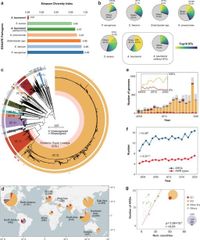In a groundbreaking study, researchers have revealed a new epidemic super-lineage of Acinetobacter baumannii, a formidable pathogen responsible for a slew of multidrug-resistant infections. This newly identified lineage, which is accountable for approximately 70% of clinical isolates worldwide, underscores the urgent need for comprehensive infection control strategies.
Historically, Acinetobacter baumannii has posed significant challenges in hospital settings, where it is a leading cause of nosocomial infections. The bacterium has shown alarming levels of resistance not just to standard antibiotic regimens but also to many of the frontline treatment options. As of 2019, this pathogen was linked to an estimated 326,000 deaths globally, drawing attention to the pressing need for effective containment measures.
The study, which involved genomic analysis of over 15,000 A. baumannii strains from 88 countries, identified a major epidemic super-lineage (ESL) and highlighted the emergence of a novel clade, termed Clade 2.5.6. First detected in East Asia in 2006, Clade 2.5.6 is distinctly characterized by its rapid global spread and acquisition of antimicrobial resistance genes (ARGs).
Understanding the genetic landscape of this pathogen is critical. High rates of genetic recombination facilitate the movement of ARGs across populations, creating a complex web of resistance mechanisms. The researchers leveraged extensive genomic data coupled with hierarchical classification techniques to delineate the population structure of A. baumannii. Their analysis indicated that the ESL displays a remarkably low genetic diversity, primarily due to the dominance of sequence type 2 (ST2), accounting for nearly 44% of all analyzed strains.
As resistance patterns evolve, the clonal expansion of such strains raises alarm bells in the medical community. The CDC has termed the ability of A. baumannii to rapidly accumulate resistance genes as a critical public health concern, especially given that many strains have displayed pan-resistance, making them virtually untreatable within existing therapeutic frameworks.
One notable finding from this study is the increased prevalence of carbapenem-resistant A. baumannii (CRAB) strains, which have become prevalent due to widespread antibiotic use in healthcare settings. This not only complicates treatment options but also drives up the mortality rates linked to infections caused by this pathogen. In terms of genetic evolution, the study shows a significant uptick in colistin resistance among clinical isolates, further narrowing treatment avenues for healthcare practitioners.
Amidst the concerning trends, there is a beacon of hope through genomic surveillance and advanced bioinformatics tools. This study highlights the development of a genotyping tool, known as Capybara, which facilitates rapid categorization of strains based on genetic traits, thereby enhancing the ability to track and control outbreaks effectively.
As the research progresses, the necessity for a One Health approach—integrating human, animal, and environmental health—is emphasized by the findings. The global nature of this epidemic underscores that tackling A. baumannii effectively requires multi-faceted interventions and close collaboration between medical, environmental, and agricultural experts.
Looking forward, the researchers stress the importance of continued genomic surveillance and targeted public health strategies to mitigate the impact of multidrug-resistant pathogens like A. baumannii. This includes ongoing efforts to better understand its emergence, geographical spread, and the molecular mechanisms driving its resistance traits.
As we reckon with the escalating threat of antimicrobial resistance in a globally interconnected world, this study serves as a clarion call for immediate and robust action to preserve the efficacy of our current antimicrobial arsenal and safeguard public health.




